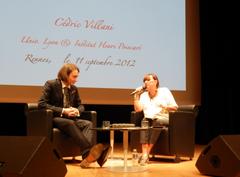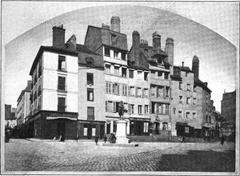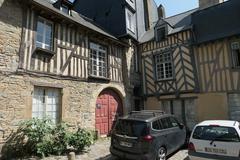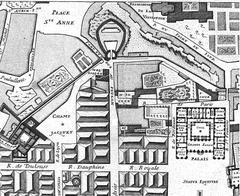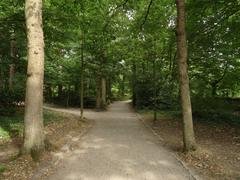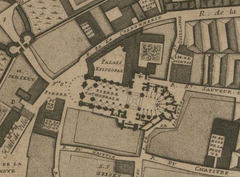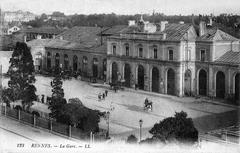
Maison des Filles de la Charité Rennes, France: Visiting Hours, Tickets, and Historical Site Guide
Date: 03/07/2025
Introduction
The Maison des Filles de la Charité in Rennes stands as a living testament to nearly four centuries of charitable service and religious devotion. Founded in the late 17th century during the expansion of the Compagnie des Filles de la Charité de Saint Vincent de Paul, this site reflects the congregation’s ongoing mission to serve the vulnerable populations of Rennes through healthcare, education, and social aid. Its elegant yet functional architecture and its enduring legacy of compassion make it a significant cultural and historical landmark. This comprehensive guide explores the Maison’s history, architectural features, social impact, and provides essential visitor information, including opening hours, accessibility, ticketing, and nearby attractions.
For further details and historical context, authoritative resources such as the Ministère de la Culture’s base Mérimée and the Province des Filles de la Charité archives are invaluable references.
Table of Contents
- Introduction
- History and Foundation
- Architectural and Cultural Significance
- Social Impact and Evolution
- Practical Visitor Information
- Frequently Asked Questions (FAQ)
- Conclusion
- References
History and Foundation
The Maison des Filles de la Charité in Rennes is intrinsically linked to the history of the Compagnie des Filles de la Charité de Saint Vincent de Paul, founded in Paris in 1633 by Saint Vincent de Paul and Saint Louise de Marillac. Their mission to serve the poor, sick, and marginalized quickly spread across France. In Rennes, the sisters established themselves in 1673, initially managing a charitable soup kitchen, and by 1683 had settled in their own house on Rue du Griffon (loomji.fr). The Maison was reconstructed to accommodate their expanding community and charitable activities, becoming a landmark of social care in Rennes.
The Maison’s foundation was part of a broader movement to address poverty and social injustice, with the sisters providing home care for the sick, education for girls, shelter for orphans and the elderly, and support for many marginalized groups (chapellenotredamedelamedaillemiraculeuse.com; filles-de-la-charite.org).
Architectural and Cultural Significance
Built in 1683, the Maison des Filles de la Charité reflects the sober, utilitarian style typical of late 17th-century religious architecture in Brittany. The main building features two upper floors above a ground floor, a mansard roof topped with a campanile, and a façade of rendered rubble masonry and timber framing. The structure was originally designed as both a convent and a center for social aid. Elements such as original window joinery and the dependency on Rue du Griffon offer visitors a glimpse into the craftsmanship and practical design of the era (loomji.fr; monumentum.fr).
Classified as a Monument Historique since June 16, 1965, the Maison’s preservation ensures that its historical and architectural legacy endures as a symbol of the congregation’s work and the city’s heritage (pop.culture.gouv.fr).
Social Impact and Evolution
From its earliest days, the Maison played a central role in Rennes’ social infrastructure. The sisters provided nursing care, food distribution, and education, adapting their services to respond to the changing needs of society. During crises such as epidemics and wars, their contributions were especially vital—for example, during the 19th-century health crises and the World Wars, when the Maison served as a refuge and infirmary (daughtersips.org; fillesdelacharite-province-bfs.fr).
Today, while the religious community has diminished in size, the Maison continues its legacy of service, currently housing the Bureau d’Aide Sociale de Rennes. Its ongoing adaptation reflects the enduring relevance of the values of humility, charity, and solidarity.
Practical Visitor Information
Opening Hours
- The Maison is typically open Monday to Friday, 9:00 AM to 5:00 PM.
- Hours may vary on holidays or during special events—verify with local sources before your visit.
Tickets and Guided Tours
- General access to the Maison’s exterior is free.
- Guided tours, often organized during heritage days or by local associations, may require prior reservation and a nominal fee (usually €3–€10).
- Group and school visits can be arranged by appointment with the Rennes Tourist Office or local heritage organizations.
Accessibility
- The site is partially accessible to visitors with limited mobility. While ramps and adapted facilities are available, some historic features and cobblestone streets may present challenges.
- Notify staff in advance regarding specific accessibility needs.
Getting There
- By Public Transport: Bus lines 2, 12, and 44 (stop: Saint-Hélier); Rennes Metro (Line A) with nearby stops “Charles de Gaulle” and “Parlement.”
- By Car: Public parking garages such as “Parking Charles de Gaulle” and “Parking Saint-Georges” are within walking distance.
Photography and Visitor Tips
- Exterior photography is permitted and encouraged, especially to capture the building’s unique architectural details.
- Interior access is limited and typically only available during special events; respect any photography restrictions inside.
- Modest attire is recommended to honor the religious character of the site.
Nearby Attractions
- Rennes Cathedral: A masterpiece of religious architecture.
- Parlement de Bretagne: Historic parliament building and museum.
- Place des Lices: Famous for its vibrant market and lively atmosphere.
Frequently Asked Questions (FAQ)
Q: Is there an entrance fee?
A: General access is free; guided tours may charge a small fee.
Q: Can I visit the interior?
A: Interior visits are generally available only during special events or by appointment.
Q: Are guided tours available?
A: Guided tours are organized during heritage days and special events—advance booking is advised.
Q: Is the site accessible for people with disabilities?
A: Some areas are accessible, but historic features may limit full access. Contact the site in advance for arrangements.
Q: Is photography allowed?
A: Yes, for the exterior; interior photography is subject to restrictions.
Conclusion
The Maison des Filles de la Charité is more than a historic monument—it is a living symbol of enduring charity, faith, and community service in Rennes. From its foundational role as a center for the poor and sick to its modern adaptation as a social aid hub, the Maison continues to reflect the values of the Daughters of Charity. Its architectural preservation and accessibility make it an essential destination for anyone exploring Rennes’ religious and social heritage.
To stay updated on visiting hours, events, and guided tours, check resources like the Rennes Tourist Office and the Province des Filles de la Charité. For a richer cultural experience, combine your visit with other notable sites in Rennes’ historic quarter.
References
- Ministère de la Culture, Base Mérimée
- Province des Filles de la Charité, Archives
- Monumentum, Maison des Filles de la Charité Rennes
- Filles de la Charité International, Who We Are
- Rennes Tourist Office, Official Site
- Loomji, Rennes Monument Details
- Congrégation des Filles de la Charité du Sacré-Cœur de Jésus




